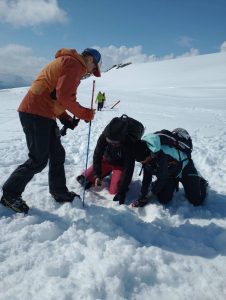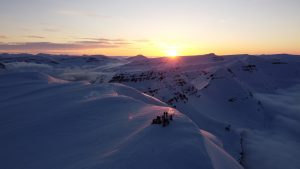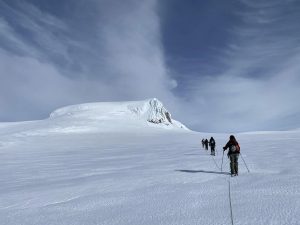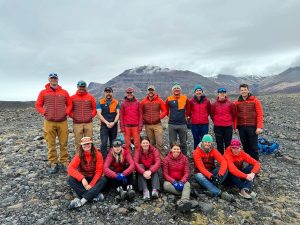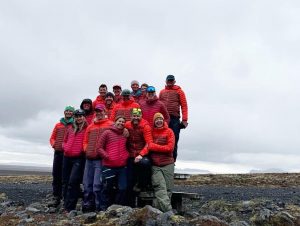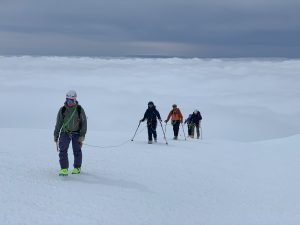Ex Snjor Mountaineer was the Army Mountaineering Association’s recent flagship ski mountaineering expedition to Iceland, which aimed to prepare for and then summit Iceland’s highest peak, Hvannadalshnúkur – a feat that had not previously been achieved by a British Military team. WO2 Ross Penver, the Exped leader, aimed for the Expedition “to expose a group of ski mountaineers to climbing and skiing in a more remote and more challenging environment than they have previously experienced, thus promoting the development of leadership, teamwork and personal resilience.”
The preparatory phase was based in the East Fjords which are known for their dramatic landscapes; they are characterised by steep mountains, deep fjords and extensive snowfields. This region offers a unique and challenging environment for ski expeditions, with opportunities to develop skills and practice rescue procedures in technical terrain, pushing even experienced skiers out of their comfort zone.
Background: A surge of volcanic activity, coupled with a period of intensive snowfall prior to our arrival in the eponymous Land of Fire and Ice, had glued us to news reports, synoptic charts and avalanche bulletins in the preceding months. Skaᵭi nonetheless smiled favourably on our endeavours and the snowfall was followed by an extended cold front which stabilised much of the snowpack, opening more options for our training area. The accuracy and frequency of up-to-date information found on online resources such as The Icelandic Meteorological Office (IMO) were invaluable and cannot be understated for their use in expedition planning.
All team members were trained to a minimum of Ski Foundation Level 3, which meant everyone had prior experience with the British Military skiing off-piste, ski touring and conducting avalanche rescue training. All members were equipped with avalanche transceivers, shovels, and probes, with additional safety equipment assessed for each training day. Avalanche risks were carefully monitored using snowpack tests and weather forecasts. Detailed map study, combined with consulting the IMO avalanche bulletin and weather conditions were used to select the appropriate route for specific training objectives throughout the trip.
Aside from safely navigating the East Fjords and Iceland’s highest peak, a secondary objective of the Expedition was local outreach and sustainability in line with the British Military’s Sustainability policy. The team had made connections with the Vatnajökull National Park to support the work and staff that protect the integrity of Europe’s largest glacier. As mountaineers, and particularly winter focused mountaineers, sustainability is central to protecting and participating in the winter mountain environment. Ski mountaineering is inherently challenging, complex and engaging, but provides an opportunity to gain a deeper awareness of the natural world.
The team gathered in Aldershot on Saturday 20th April for a kit issue and was the first opportunity for everyone to come together in person. The selection process had been robust, with over 120 applicants competing for 12 participant spots. Of the total team of 15, there were seven women, six Reservists, and eight cap badges represented, ranks ranging from Sapper to Colonel, leading to a fantastic mix of experience, skills, and outlook.
Expedition
Days 1 & 2 – Travel to the East Fjords: On Sunday 21 Apr, the team flew from London Heathrow to Reykjavik, equipped with a vast amount of ski gear and safety equipment, including avalanche backpacks which were thankfully accepted onto the flight by IcelandAir. The following day consisted of a 13-hour drive (inclusive of a couple of sightseeing stops at hot springs and geysers) clockwise around the north of Iceland on Highway One, the country’s iconic main driving route. We arrived at our accommodation in Eskifjörᵭur as the sun was dipping below the horizon, settling into what was to be our base for the following eight days of preparatory training.
Day 3 – Eskifjörᵭur Introductory Tour: We started our ski training with 750m of ascent over 7 miles, split into two teams within radio reach of each other, but aiming for different objectives. The teams conducted refresher avalanche training, followed by an amazing off-piste descent directly to the minibuses parked at the roadside. Upon our return, expedition Medical Officer Lt Col Hazelrigg familiarised us with medical kit and procedures which would be most relevant to this type of ski mountaineering expedition, particularly taking into consideration our geographical isolation that would render helicopter rescue from Reykjavik not only time-consuming, but altogether uncertain in cases of bad weather.
With daylight until at least 10pm, we enjoyed an evening excursion to a small ski resort close to our accommodation. Although limited in area, with just a handful of button lifts, the area made up for it with outstanding views and fantastic snow conditions. The instructors delivered a performance and technique workshop, as well as giving individual tips prior to more challenging skiing later in the trip.
Day 4 – Hiking, Skiing and Sunset Tour: We awoke on Wednesday to cloud inversion, which initially felt disappointing after the perfect ‘bluebird’ conditions of Tuesday, but headed out with optimism nonetheless. The groups, split into two as would be standard for the whole preparatory phase, had different objectives in different locations, but both involved hiking to the snowline with skis and boots secured on backpacks. One group’s hike was longer but their ski touring ascent less technical; it was a big day for both groups, with each completing over 1000m of vertical ascent.
That evening the team undertook a sunset tour, starting at the ski resort we had skied the previous night and completing a very quick 500m of vertical ascent to ensure we arrived at the peak before the sun went down. The views were stunning, captured on drone by instructor and drone pilot extraordinaire Captain Will Brant, and the tour was most definitely an early highlight of the trip.
Days 5-7 – Couloir Challenges! One team faced the start of technical ski mountaineering challenges on Thursday, which involved a short hike in trainers up to the snowline, before donning skins and progressing up a couloir. Couloir training had included the use of ice axes, crampons and harnesses. The climb was hard work and incorporated use of ropes for lowering off the col to understand alternative descent options. It was technical and steep, but a great ski down. The other team’s less technical ski tour was cut short for safety reasons due unexpected cloud inversion in a different part of the Fjords; unfortunate but not unusual in an area known for its microclimates and an important reminder of just how changeable mountain weather systems can be.
The teams were changed around on Friday to ensure the appropriate mix of challenge and safety, with one team conducting another couloir climb, and the other a less technical ski touring day. The couloir team faced a steeper day than before in a glacier fed fjord, opposite the aluminium smelter Fjarðaál. The conditions were challenging, and a decision was reached not to summit due to worsening snow and intensifying wind gusts higher in the couloir. Critical safety decisions were made during the descent to avoid dislodged rocks seen in previous avalanche debris fields. Iceland’s coastal winds can reach 90 miles (145 kilometres) per hour, and the team certainly gained a sense of the wind strength at points during the climb. The other team enjoyed clear, calm and sunny weather to reach a less technical, but still highly enjoyable, objective.
The team enjoyed an evening meal out in the traditional setting of a historic fisherman’s hut on Friday night, as the local owner warned the instructors of the bad weather coming in. The timing of this was convenient as it coincided with a rest day, so the team enjoyed the Saturday at local thermal baths beside a frozen lake, with some braving a very icy (and quick!) swim in the latter!
Days 8-10 – Safety Training and Final Preparatory Tour: Continuing poor weather conditions on Sunday morning limited options for ski touring but provided the perfect opportunity for the team to conduct crevasse rescue training and more advanced avalanche rescue skills at the nearby ski resort. As the weather cleared in the afternoon, we conducted a short ski tour from the base of the resort and some off-piste ski technique analysis on the descent.
Given a choice of teams for Sunday’s ski tour, we decided on girls vs boys for a bit of friendly competition! This day provided the toughest ski conditions yet, with poor visibility and ‘grabby’ snow for the majority of the descent back down to the roadside. However, it was necessary training that gave us another 800m of vertical ascent and some tricky descent experience under our belts prior to the upcoming big day – the summit attempt.
Monday involved a full day of travel from the East Fjords to our base in the south of the country, from which we had a 3-night and 2-day window to attempt to summit Hvannadalshnúkur. A stop on the way at the glacial lake, with Iceland’s highest peak looming ominously in the backdrop, was a stark reminder of the challenges to come. Nerves could be felt that night at our hostel as the team took it in turns to cook for each other and pack for the summit. Limited by what looked to be a short good-weather window, the instructors had decided we would be leaving that night.
Day 11 – Summit Day: Alarms went off at 0200 after just a couple of hours of sleep, and, following a hasty breakfast, the team bundled ourselves and our kit into the minibuses for the 45 minute drive to the start point, a layby at the base of Hvannadalshnúkur. We were several hundred metres below the snowline at this point, so skis and boots were attached to backpacks in an ‘A-frame’ style, as we started our uphill trek just before 4am. This part of the ascent took just under 2 hours, at which point we were relieved to see the snow and transition to skis. For the next three hours the team ski toured up and onto the glacier, stopping for five minutes on the hour, every hour, for a quick drink and snack break. As the crevasse risk heightened the group split into our ‘rope’ teams; three teams of five, roped together due to the risk of crevasses present on the glacier.
On the final steep section towards the ascent some team members were struggling to get enough traction on the icy snow with the crampons attached to their skis and were repeatedly slipping. As a result, the instructors made the decision to ditch skis and fix boot crampons, aiming to ‘bootpack’ the final leg up to the summit. It was a feeling of elation and hugs all round, when, eight hours after we had started our ascent at sea level, we made it the 2,100m up to the top of Hvannadalshnúkur – a feat we believe we were the first British team of soldiers to achieve.
Unfortunately, due to minor injury one member of the team was unable to summit, and an instructor stayed behind in support; both were able to descend safely. The descent was made more complicated by the dense cloud which had now formed, with visibility limited to only a few metres at points. WO1 Luke Kemp led us expertly through the ‘white-out’ across a large and featureless glacial plateau, including over a crevasse, and provided support and encouragement to team members who had vertigo (in these sorts of conditions it can feel like the mountain is moving underneath you, and it is difficult to orientate oneself, leading to dizziness and a lack of balance for some). We returned back to the vehicles at 4pm, just over 12 hours after we had started that morning, exhausted but delighted with our achievement.
Day 12 – Community Outreach and Conservation: After a full night’s sleep, an aching but high-spirited team drove back to the area we had been the day before, and, with Hvannadalshnúkur in the backdrop, signed into the National Park reception area at Skaftafell to partake in a community and sustainability engagement day with the national park rangers, who asked us to help them clear rocks to improve the Park’s only mountain bike trail. The team undertook this task with great enthusiasm, leaving the Rangers impressed by our energy and spirit, and the team with a feeling of reward, purpose, and appreciation for Iceland’s unique landscape which, like so many other places, is threatened by climate change. Sigrún Sigurgeirsdóttir a Specialist at Skaftafell remarked that “Having a group of people with physical strength and willingness to use it in favour of the trail making is an advantage, but the good spirit, teamwork and cooperation was of course the best part.”
Days 13-14 – Farewell Iceland: The following day the team followed Highway One back to Reykjavik, completing a loop of this spectacular loop and taking in more waterfalls, geysers, and thermal springs on the way. The Expedition finished with a well-earned day in Reykjavik and final team meal at which we were delighted to thank WO2 Ross Penver for his extensive work organising the Expedition with a traditional Viking present.
Conclusion: The ski expedition in Iceland was a successful and enriching experience, providing valuable training and insights for future adventures. The region offers a unique blend of challenging terrain and breath-taking scenery, making it a prime destination for experienced backcountry skiers. All team members benefited from the expertise of our incredible four instructors and the challenges Iceland provided, with many planning to use the experience gained in our logbooks to apply for the next level of military ski leader qualifications. Our heartfelt thanks to the Ulysses Trust for such a generous donation which helped ensure this trip was able to run, and which supported the third of the team on it who are serving Reservists.

